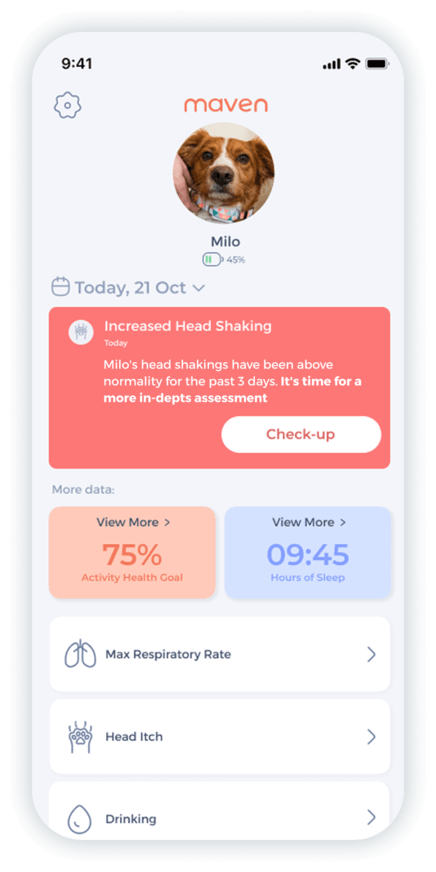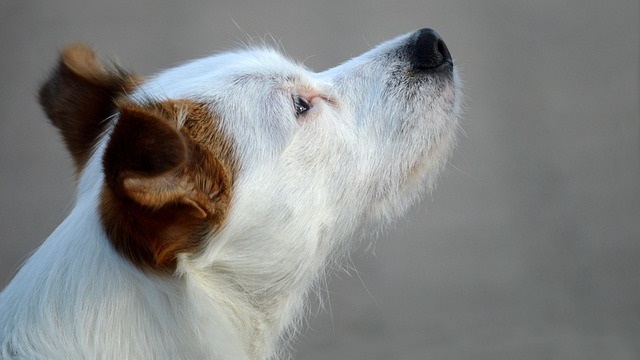Why Is My Dog’s Eye Red? Causes and When to See a Vet
It’s unsettling to look at your dog and suddenly wonder, “Why is my dog’s eye red?” Whether it appeared overnight or after a walk in the woods, a red eye can signal anything from a mild irritant to a medical emergency. Your puppy may have rubbed its face on the carpet, played too roughly at the dog park, or stuck its head out the car window and caught some debris.
Although some causes, such as dust or dry air, are harmless and resolve quickly, others, like glaucoma or a scratched cornea, require immediate attention. It’s essential for all pet parents to recognize the signs so they can determine when it’s time to visit the vet.
- Red eyes in dogs can indicate conditions ranging from minor irritants to serious issues like glaucoma, requiring timely veterinary attention.
- Key warning signs include swelling, discharge, or behavioral changes, indicating a need for immediate vet consultation.
- Tools like the Maven Pet Health Monitor can help detect early signs of health issues, promoting proactive care for your dog.
What Causes Red Eyes in Dogs?

If your dog has red eyes, it’s more than just a cosmetic issue. It’s a sign that something might be bothering their eyes. Red eyes in dogs have many causes, and pet owners should know about the following:
Conjunctivitis (Pink Eye)
Conjunctivitis in dogs is a common condition that inflames the conjunctiva, the lining of the eye, causing redness, excessive blinking, swelling, and a yellow or greenish discharge. This is an inflammation of the surface of the eye (cornea) that can be caused by infections (bacterial or viral), trauma, or allergies, and is often contagious among dogs.
Allergies
Dogs can react to various substances, including pollen, mold, food, dander, and even cleaning products. If your dog has red eyes and watery discharge, discomfort, along with sneezing or itching, allergies might be the issue, especially during spring. Such conditions are treated with oral medication, such as antihistamines, or eye drops.
Irritants Like Dust or Smoke
Just like people, dogs’ eyes can get irritated by environmental factors. A walk on a windy day or exposure to smoke from a barbecue can cause temporary redness.
Foreign Object in the Eye
A grass seed, a speck of dirt, an eyelash trapped within the eye, or sand can get lodged in your dog’s eye, which can lead to redness, bloodshot eyes, and pawing at the face. This situation is quite normal, especially in adventurous canines that love running through bushes and tall grass.

Injuries or Scratches
Rough play, a swipe from another pet, tree branches, or toxic gases/fumes can cause eye trauma. Eye ulcers are commonly caused by trauma, and this typically leads to redness, squinting, excessive tearing, or bleeding.
Glaucoma or Increased Eye Pressure
This serious condition requires urgent medical attention, as it can lead to permanent blindness. It is caused by increased eye pressure and a buildup of fluid in the front part of the eye. The common signs of glaucoma include bulging, redness, pain, eye haziness, and changes in vision. There are several reasons why it occurs in dogs, including uncontrolled or poorly regulated diabetes, hereditary factors, or other disease processes.
Dry Eye (Keratoconjunctivitis Sicca)
When tear production decreases, the eyes become dry, red, and irritated, often producing mucus or eye gunk. This leads to a dog losing its normal protective function of the eye surface, and is particularly common in breeds such as Pugs, Shih Tzus, and Bulldogs. It’s worth noting that this issue often goes hand in hand with other conditions, such as diabetes.
“I got the Maven sensor for my 14-year-old Chihuahua mix with heart and trachea issues. It gave me back peace of mind – I can track her RRR, BPM, drinking, and activity anytime and know instantly if something’s wrong. Highly recommend!”

★★★★★
Chiara De Luca
Titti
When Should You Be Concerned?
It’s natural to worry when your dog’s eye suddenly looks irritated, especially if other symptoms appear. If you’ve been asking, “Why is my dog’s eye red and swollen?” or noticed your canine friend acting off, here are four warning signs that mean it’s time to call the vet.
- Eye appears swollen or oozing — If the eye is puffy or producing yellow or green discharge, it may be due to an infection, injury, or blocked tear duct. For example, after a hike, a stick or plant may have scratched your dog’s eye.
- Dog is pawing or rubbing its eye constantly — Frequent rubbing can worsen the issue and might mean something is stuck in the eye or it’s painful. This occurence can also lead you to wonder, “Why is my dog licking his paws?”, which is actually a common sign of discomfort.
- Sudden onset of redness with behavioral changes — A quick change in eye color, plus anxiety or hiding, could indicate something serious like glaucoma or trauma.
- Accompanied by lethargy or discharge — A dog with red eyes and tired behavior might have a systemic infection or fever. If your furry friend has red eyes and tires easily, seek vet care immediately.
Can You Treat Red Eyes at Home?

If you’ve noticed redness in your dog’s eye, your first thought might be, “Can I try a dog red eye home treatment?” Yes, some mild cases can be soothed at home, but caution is crucial. Eye issues can worsen quickly, so it’s important to recognize what’s safe and what’s not. Here are the dos and don’ts:
- Gently flush with saline (if recommended by a vet) — A vet-approved saline rinse can help remove dust or minor irritants. It’s sometimes used after walks or exposure to pollen, but only if your vet confirms it’s safe.
- Avoid using human eye drops — Never use over-the-counter drops meant for people. They can cause irritation or damage to your dog’s eye and won’t treat underlying conditions.
- Keep the area clean and monitor for changes — Use a clean, damp cloth to gently wipe away discharge and watch for swelling, color changes, eye rubbing, or squinting. Sudden symptoms might have you asking not only “Why is my dog’s eye red?” but also “Why is my dog breathing fast?”, which is a sign of pain or distress. Additionally, keep your dog away from triggers such as smoke, fumes, pollen, and dust until the cause has been identified.
- Always consult a vet before treating eye conditions on your own — Even if symptoms seem mild, a vet visit is the safest route to protect your dog’s vision and comfort.
How the Maven Pet Health Monitor Supports Early Detection

When Bella, a five-year-old Golden Retriever, began waking more at night and rubbing her face on the couch, her owner didn’t think much of it until the Maven Pet Health Monitor flagged a sudden increase in restlessness and scratching.
This discreet pet smart collar tracks patterns such as sleep disruption, restlessness, and scratching behavior, which are often the earliest signs that something is wrong. In Bella’s case, the device alerted her owner to these subtle changes and prompted a vet visit that revealed early-stage conjunctivitis, a common cause of red eye in dogs.


Monitor heart rate, respiratory rate, activity & rest, drinking, itch behavior.
By flagging unusual behavior before symptoms become apparent, Maven supports proactive care. It alerts owners to discomfort or irritation that might otherwise go unnoticed, such as eye redness caused by allergens, dry air, or early signs of infection. This helps catch issues early, minimizes discomfort, and prevents complications.
As part of a growing focus on pet wellness, the Maven Pet Health Monitor not only tracks activity but also helps protect your dog’s health through timely, informed intervention.
Conclusion

As we have already established, red eyes in dogs can result from a variety of causes, including allergies, infections, irritants, or more serious conditions such as glaucoma. Key warning signs, such as swelling, discharge, behavioral changes, or constant rubbing, should never be ignored.
If you’re still asking, “Why is my dog’s eye red?” and notice these symptoms, it’s best to seek veterinary care promptly to avoid complications. For added peace of mind, consider using a tool like Maven’s pet smart collar, which supports pet health by tracking early changes in sleep patterns, scratching behavior, and discomfort levels. It can help you spot subtle symptoms early, before a red eye becomes a more serious issue.
Maven Pet focuses on improving the quality of life of our pets with technology, using artificial intelligence (AI) to enable proactive pet care. By accurately collecting and monitoring pet data 24/7 and flagging any irregularities, Maven Pet empowers pet parents and veterinarians to stay ahead of potential health issues, ensuring the well-being and longevity of our beloved companions.




